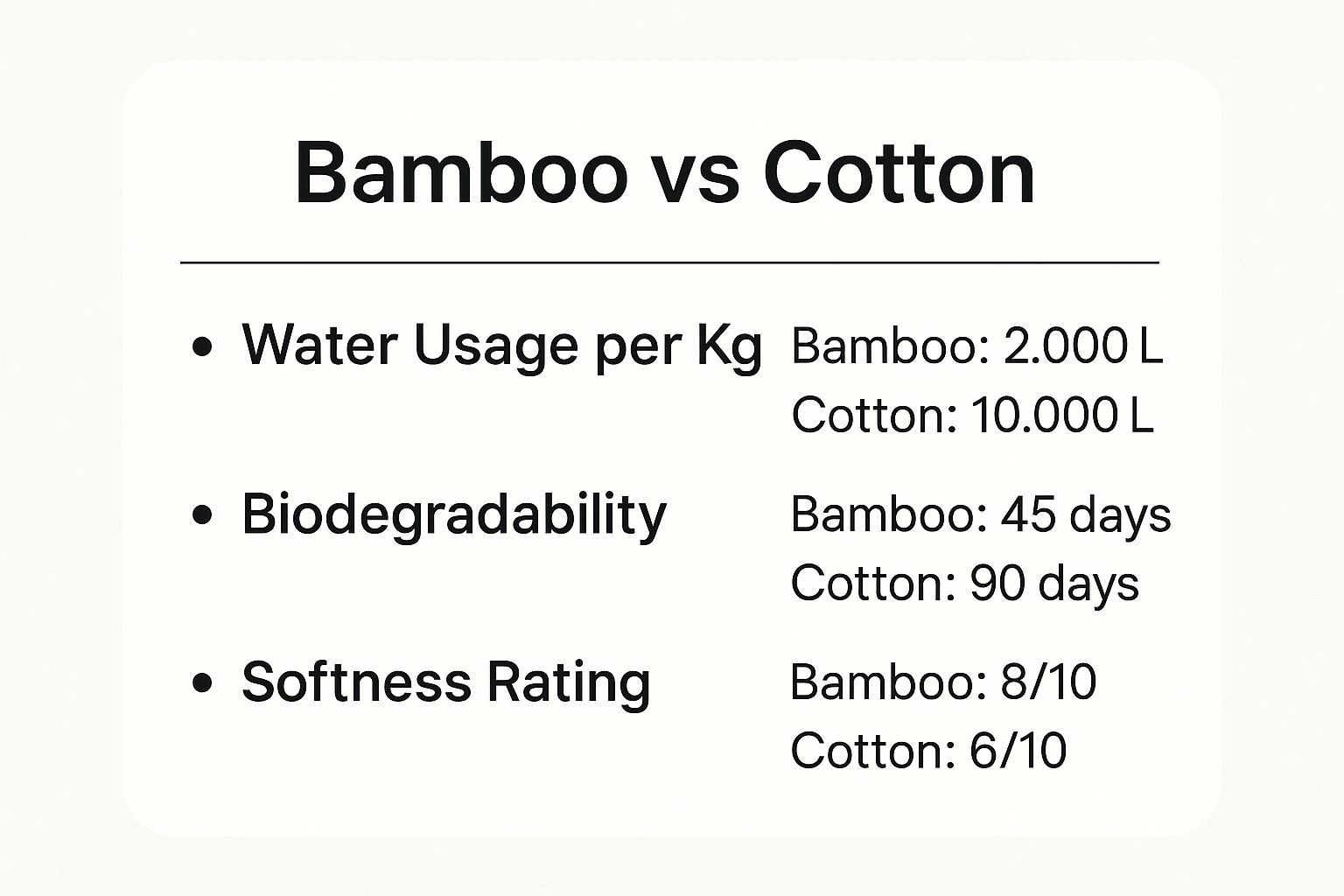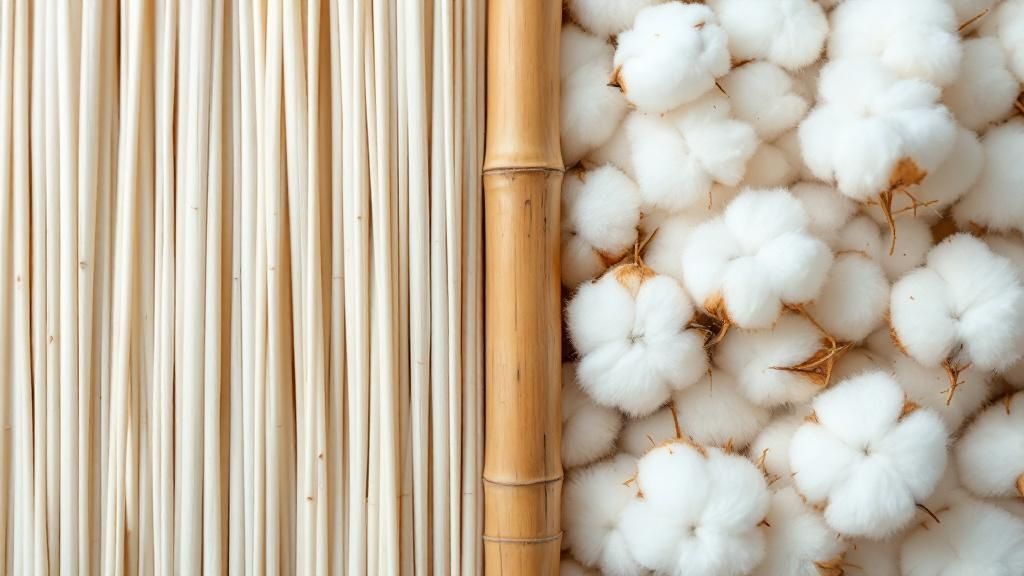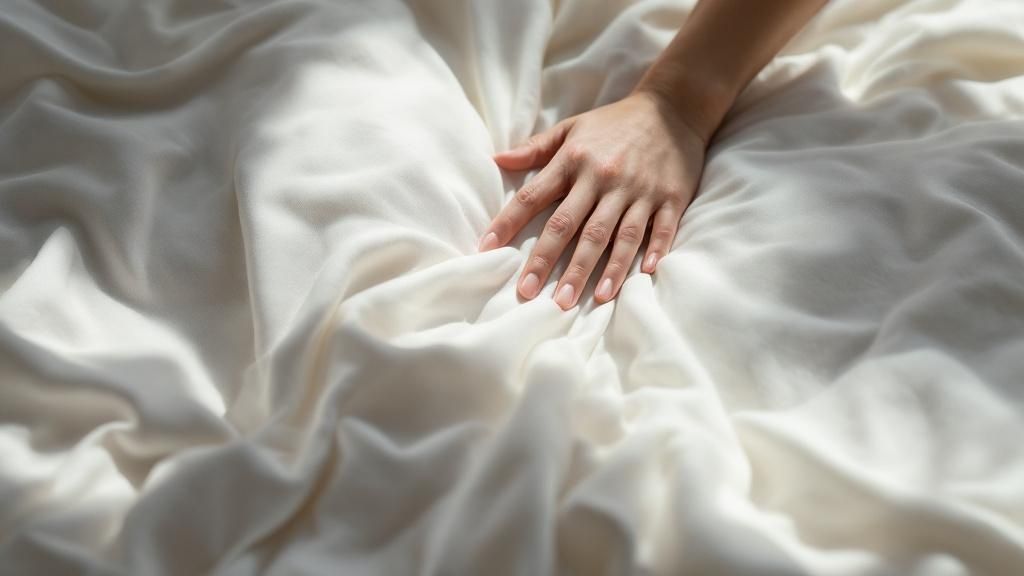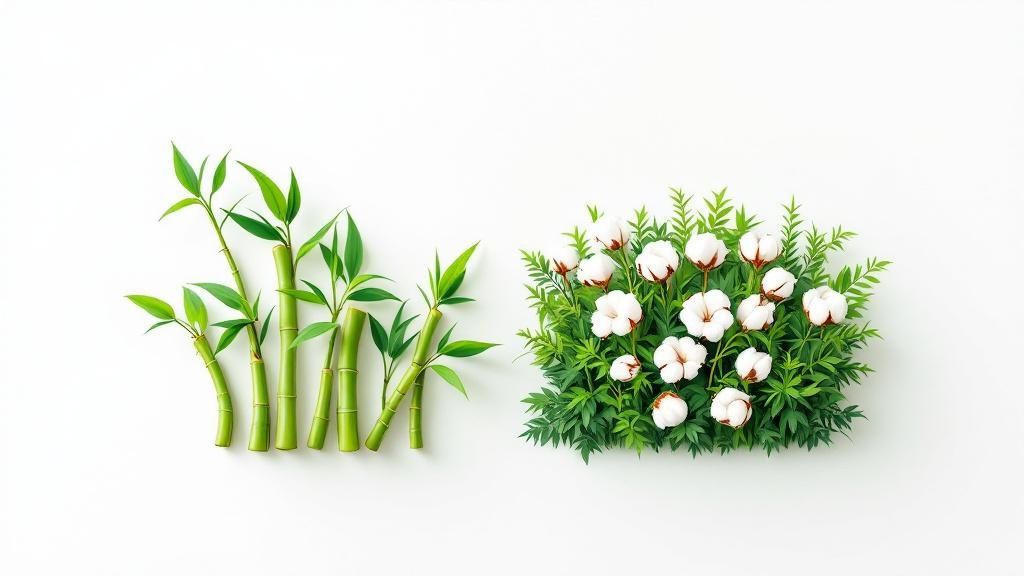When you’re weighing bamboo sheets vs cotton, the best choice really boils down to what you want to feel when you slide into bed at night. If you’re after a silky, cool-to-the-touch sheet that’s a dream for sensitive skin, bamboo is hard to beat. On the other hand, if you love that classic, crisp hotel-bed feel that gets softer with every wash, traditional cotton is still a fantastic, reliable choice.
Breaking Down the Bedding Battle
Let's be honest, shopping for bedding can feel overwhelming. You're hit with terms like thread count, percale, and sateen, when all you really want is a great night's sleep. The bamboo vs. cotton debate is one of the biggest conversations in bedding right now, and for good reason—each one brings something totally different to the table. Figuring out those differences is the key to investing in your best rest.
This visual breakdown cuts through the noise, showing how bamboo and cotton stack up on key comfort and environmental factors.

It's clear that bamboo often takes the lead in sustainability and that immediate, out-of-the-package softness—two things a lot of us are looking for these days.
To make this even simpler, here's a quick side-by-side look at the two fabrics.
Quick Comparison: Bamboo vs Cotton Sheets
| Feature | Bamboo Sheets | Cotton Sheets |
|---|---|---|
| Initial Feel | Silky, smooth, and drapey | Varies: Crisp (percale) to smooth (sateen) |
| Temperature | Excellent at wicking moisture; feels cool | Breathable but can retain some moisture |
| Sustainability | Grows fast with less water and no pesticides | Varies; organic cotton is better, but conventional is resource-intensive |
| Durability | Very durable but needs gentle care (cold wash) | Extremely durable and handles hot washes well |
| Cost | Typically higher initial price point | Wide range of prices, often more affordable |
| Best For | Hot sleepers, people with sensitive skin | Anyone who loves a classic, crisp feel |
This table gives you a snapshot, but the right choice often comes down to your personal sleep habits and what you value most.
Key Factors to Consider
Picking the perfect sheets goes way beyond color. Think about how you sleep, whether your skin is easily irritated, and even the climate you live in. These details make a huge difference.
-
Feel and Texture: Bamboo has a unique, liquid-like drape that feels incredibly smooth against the skin, almost like silk but without the slipperiness. Cotton’s texture is all about the weave—percale gives you that light, airy crispness, while sateen offers a buttery-soft finish.
-
Temperature Regulation: This is where bamboo really shines. It’s a master at thermoregulation, pulling moisture away from your body to keep you cool and dry all night. Cotton is certainly breathable, but it can sometimes hold onto moisture, which might not be ideal if you tend to sleep hot.
-
Durability and Care: Both fabrics are built to last, but they appreciate different kinds of care. To keep bamboo sheets feeling their softest, you’ll want to wash them on a gentle cycle with cold water. Cotton, on the other hand, is a workhorse—it can handle tougher wash cycles and higher temperatures.
A huge part of this conversation is driven by the growing desire for more sustainable products in our homes. People are paying more attention to how their bedding is made and its impact on the planet.
We’re seeing this shift in real-time. Consumer demand for eco-friendly bedding, including both bamboo and organic cotton, has jumped by about 20% in the last few years. Bamboo is often highlighted for its green credentials since the plant shoots up quickly without needing much water or any pesticides. For a deeper dive into these kinds of bedding trends, the research from the Sleep Foundation is a great resource.
Decoding Bamboo Sheets: Softness and Sustainability
Ever wondered how a tough bamboo stalk transforms into those incredibly soft sheets you love? It’s a fascinating process. When you see terms like "viscose," "lyocell," or "modal" on the label, it means the bamboo has been broken down and reformed into a regenerated cellulose fiber. This journey from plant to fabric is what gives bamboo bedding its signature silky feel and its unique environmental footprint.
The secret to that buttery-soft texture lies in the fibers themselves. They are naturally long and smooth, which is a game-changer for anyone with sensitive skin. Unlike rougher fabrics that can cause irritation, these smooth threads create a gentle, soothing surface to sleep on.

This is a huge reason people are swapping their traditional cotton sets for bamboo. While a great set of cotton sheets is certainly soft, bamboo offers a fluid-like texture that drapes over your body in a way few other fabrics can.
Are Bamboo Sheets Genuinely Eco-Friendly?
Bamboo has a stellar reputation as a sustainable resource, and for good reason—but it’s not always a simple story. The plant itself is a true force of nature. It’s one of the fastest-growing plants in the world and needs far less water than conventional cotton—sometimes using up to 90% less. Plus, it often grows just fine without any pesticides.
However, turning that hardy plant into a soft fabric is where things get complicated. This is where you need to pay attention to the type of bamboo fabric you're buying.
- Viscose (or Rayon): This is the most common and oldest method. It relies on a chemical-heavy process to break down the bamboo pulp. The key here is to find brands that use a "closed-loop" system, which means they recycle the water and chemicals instead of releasing them into the environment.
- Lyocell: A much more modern and eco-friendly process. It uses a non-toxic solvent in a closed-loop system from the start, making it a significantly more sustainable choice.
The biggest sustainability win for bamboo really comes from how it's grown. Its rapid growth and minimal need for resources give it a massive advantage over water-guzzling crops like cotton.
By choosing brands that are transparent about their manufacturing, you can feel good about your purchase. For anyone still weighing the bamboo sheets vs cotton decision, the eco-friendly angle is a big point in bamboo's favor. If you want to dive deeper, check out these 20 reasons bamboo sheets are better. It’s this blend of pure comfort and conscious production that makes bamboo bedding a truly special choice.
Cotton Sheets: The Classic Choice for a Reason
Cotton has been the go-to choice for bedding for as long as most of us can remember, and there's a good reason for it. It's the fabric we know and trust. But if you've ever shopped for sheets, you know the feeling can range from scratchy and stiff to unbelievably soft. What gives?
It all boils down to a few key details that separate the good from the truly great. The most important thing to look at is the type of cotton itself.

It Starts with the Fiber
The real secret to high-quality cotton is the length of its fibers, what the industry calls the staple. The rule is simple: longer fibers can be spun into finer, stronger, and much smoother yarns. This is where you see the biggest difference in feel.
- Egyptian and Pima Cotton: These are the superstars of the cotton world. They have extra-long-staple (ELS) fibers, which is why they produce sheets that are famously soft, incredibly durable, and resist pilling over time. If you're wondering why some cotton sheets feel so much more luxurious, this is almost always the answer.
- Upland Cotton: This is the most common variety you'll find. It has shorter staple fibers. While Upland cotton sheets are perfectly fine and comfortable, they just don't have the same softness or longevity as their premium cousins.
Weave and Thread Count: What Actually Matters
After the fiber, the next piece of the puzzle is the weave. This is simply how the threads are woven together, and it has a massive impact on how the sheets feel on your skin. A sateen weave, for example, results in a silky-smooth, almost buttery surface with a subtle sheen. On the other hand, a percale weave is all about that light, crisp, and cool feeling you get from a bed in a high-end hotel.
A word of advice: don't get tricked by sky-high thread count numbers. A 400-thread-count set of sheets made from top-notch Egyptian cotton will always feel better and last longer than a 1,000-thread-count set made from a lower-grade, short-staple cotton. Quality of fiber trumps quantity of threads every time.
Cotton’s long-standing reputation is backed by some serious numbers. The U.S. bedsheets market was valued at around USD 7.75 billion, with cotton holding the lion's share thanks to its natural breathability and hypoallergenic qualities. You can dive deeper into the bedding market's growth at Fortune Business Insights. This popularity proves that even with new materials on the scene, a great set of cotton sheets is still a major contender in the bamboo sheets vs cotton discussion.
Finding the Right Sheets for Your Sleep Style
When you’re weighing bamboo sheets against cotton, it’s not just about what’s on the label. It’s about solving what’s keeping you up at night. The right bedding is deeply personal, so let's walk through a few real-world situations to figure out what works best for you.
Let's start with a common one: the hot sleeper. If you're constantly kicking off the covers, waking up sticky, and dreading summer nights, this is you. The debate isn't just about softness; it's about survival. This is exactly where bamboo’s natural qualities shine.
Bamboo fabric is a superstar when it comes to thermoregulation. Its fibers are naturally moisture-wicking, meaning they pull sweat away from your skin and let it evaporate fast. The result is a consistent cooling sensation—like having the "cold side of the pillow" all over your bed, all night long.
Now, a crisp cotton percale is no slouch either. It's incredibly breathable and allows for fantastic airflow, which feels light and airy. But, cotton tends to absorb moisture instead of wicking it, so if you're a heavy sweater, it can start to feel a little damp. For a deeper dive on this, you can learn more about if bamboo sheets are cooling from our guide.
For Those With Sensitive Skin or Allergies
Let's switch gears. Maybe your struggle is with sensitive skin, eczema, or frustrating seasonal allergies. If you often wake up with irritated skin or a stuffy nose, your bedding might be the hidden culprit.
In this scenario, bamboo has a clear edge. Its fibers are naturally round and smooth, creating a silky surface that glides over your skin with minimal friction. This gentle feel is far less likely to aggravate sensitive skin than even high-end cotton, which can have a rougher texture depending on its weave.
Bamboo is also naturally hypoallergenic and antimicrobial. It actively resists the buildup of dust mites, mold, and mildew—all common triggers for allergies and asthma. While high-quality organic cotton is a solid hypoallergenic choice, bamboo's built-in antimicrobial properties offer an extra layer of defense for a cleaner, healthier sleep.
Considering Long-Term Value and Durability
Finally, try to think of your sheets as an investment in your well-being. While cotton sheets often come with a lower price tag initially, top-tier bamboo sheets can deliver much better value over the long haul.
How? Bamboo fibers are remarkably strong and resilient. As long as you care for them properly—think cold water washes and low-heat drying—they’ll keep their silky softness and rich color for years. Cotton is a classic workhorse, no doubt, but it's often more susceptible to pilling and can yellow over time from body oils.
So, when you're ready to decide, think about your biggest sleep challenge:
- You sleep hot and just want a cool, dry night: Bamboo is your secret weapon.
- You deal with sensitive skin or allergies: Bamboo's smooth, hypoallergenic fibers are a game-changer.
- You want a durable investment that stays soft wash after wash: Bamboo's resilient nature makes it a lasting luxury.
The Hybrid Approach: Exploring Blended Sheets

What if you don't have to choose a side in the great bamboo vs. cotton debate? For many people, the ideal solution isn't one or the other but a smart combination of both. Blended sheets represent a hybrid approach, weaving together different fibers to create a fabric that offers a unique sleep experience.
A bamboo-cotton blend, for example, can capture that silky, smooth feel bamboo is famous for while holding onto the crisp structure and reliable durability of traditional cotton. It’s a combination that often produces a sheet that’s less prone to wrinkling and, quite often, easier on the wallet.
Getting the Best of Both Materials
Think of blended sheets as being purposefully engineered to highlight the best qualities of each fiber. By weaving bamboo and cotton together, manufacturers can fine-tune the final fabric for a specific feel and level of performance.
- A Boost in Durability: The strong cotton fibers lend structural integrity to the weave, making the finished sheets more resilient to everyday wear and tear.
- A Balanced Feel: You get a healthy dose of bamboo’s signature softness without completely losing the familiar, slightly crisp texture that many people love about cotton.
- More for Your Money: Blending materials can often bring down production costs, which means the luxurious feel of bamboo becomes much more accessible.
A hybrid sheet is a fantastic practical compromise. You get the temperature-regulating and moisture-wicking benefits of bamboo, supported by the sturdy, breathable nature of cotton. It's truly a perfect middle ground for anyone on the fence.
This isn't just a niche idea; the market is taking notice. The global blended bed sheets market was recently valued at USD 109.12 billion and is expected to keep growing, with bamboo blends being called out as a key emerging segment. You can dig into the numbers in this blended fabrics market report.
And if you want to dive deeper into what makes each pure material unique, our guide on https://bamtekhome.com/blogs/bamboo-vs-cotton-sheets is the perfect place to start.
Answering Your Top Bedding Questions
When you're trying to decide between bamboo and cotton sheets, the same few questions always seem to pop up. Let's get into the nitty-gritty so you can feel totally confident in your choice.
What About Wrinkles?
I get this one a lot. The honest answer is yes, 100% bamboo sheets can come out of the dryer looking a bit more wrinkled than a polyester-cotton blend. But here's the thing: their natural, silky drape means those wrinkles tend to fall right out once you make the bed.
A simple trick I've learned is to give them a good shake right after washing and before you toss them in the dryer. Pulling them out as soon as the cycle finishes helps a ton, too.
Are Bamboo Sheets Really Worth the Price?
This is the million-dollar question, isn't it? Bamboo sheets often have a higher price tag upfront, which can give people pause.
Think of it as a long-term investment. Bamboo is incredibly durable and holds up beautifully over time. It’s far more resistant to pilling and fading than most cotton, so that "new sheet" feeling lasts for years, not just a few washes.
Caring For Your Investment
No matter which fabric you choose, taking proper care of your sheets is what will make them last. Bamboo, especially, loves a gentle touch.
- Washing: Cold water on a gentle cycle is the golden rule.
- Drying: Tumble dry on the lowest heat setting. Better yet, line dry them if you can.
- Detergents: Use a mild, liquid detergent. Steer clear of bleach and fabric softeners, as they can break down the delicate fibers.
The single biggest mistake you can make is washing bamboo sheets in hot water. It’s the fastest way to damage the fibers, causing them to shrink and lose that signature softness. Cold water is absolutely essential.
Properly washing your linens is a skill in itself. For some great, in-depth advice, check out these 5 expert tips for elevating your bed linen washing routine.
Ready to feel the difference that pure bamboo can make? At Bamtek, we craft our sheets from 100% organic bamboo viscose for a sleep that's both deeply comfortable and sustainable. Find your perfect set at https://bamtekhome.com.










